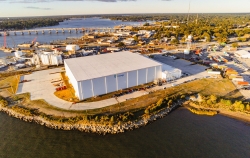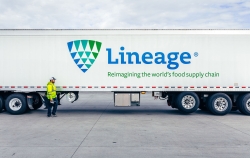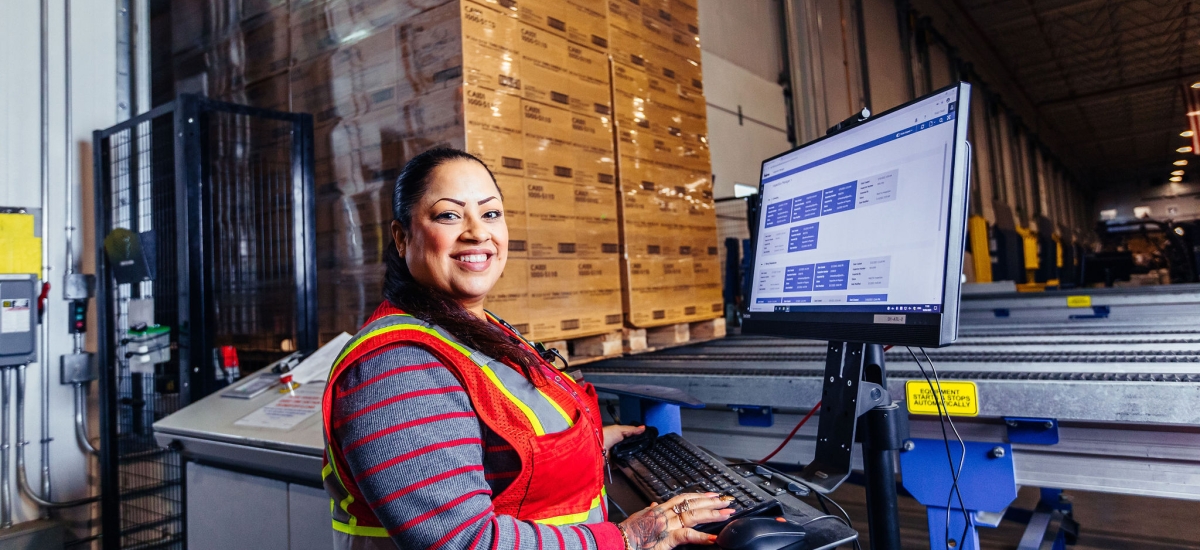Automation is Finding the Sweet Spot between Humans and Tech
A Continuation of the Series: Automation Is
February 17, 2022
The introduction of advanced technology and automation within traditional operations is often a sensitive subject, as it comes with the perception that it replaces people and jobs. This couldn’t be further from the truth. As we look for ways to reimagine the cold chain, our team members continue to play a crucial role in delivering food to people across the globe.
Demonstrating automation with empathy.
Automation in the cold chain isn’t always about doing more with less – it’s also about helping maximize the impact of our team members’ talents and efforts, while keeping them safe. By eliminating or greatly reducing the time-consuming but essential parts of the cold chain process, automation frees up our team members to focus on our customers and deliver an even higher level of service, as opposed to spending non-value-added time in harsh (-10 F) environments.
While automation enhances productivity throughout a facility, it’s also a benefit in times of urgency. When time-sensitive product is en route and a major throughway is blocked or a snowstorm blankets the East Coast, your team members who were previously ensnared in numerous hands-on tasks are now free to help determine the next course of action. This gives team members a truer sense of purpose within the organization.
When we deploy intelligent decision-making algorithms and mixed-mode automation, processes become more efficient and reduce the time team members need to spend in the freezer. One can assume there is a correlation between the hardship of working in cold storage and the higher turnover numbers we see in our industry. By creating greater efficiencies using technology, we hope to retain a greater percentage of our team members.
Automation that empowers and lessens the stresses associated with the cold chain is the essence of empathetic automation.
"Tech and automation are brand new to everyone at first, but now it is embraced. We even have forklift operators coming with ideas on how to improve processes," - Gottschalk, Operations Manager at Preferred Freezer Services.
Lineage Automation in Action: Janus
In automation, the algorithms each take over one discrete decision. When these decisions are combined to “oversee” the movements of an entire warehouse, the algorithms take many more considerations into account than any human could. Take, for example, Lineage’s algorithm, Janus. Janus selects which dock door a truck should use when loading or offloading. It does so to minimize the distance that inventory coming from or going into a truck must travel, while minimizing cross-traffic between forklifts. There are millions of ways to unload 26 pallets in various spots on the warehouse floor. Janus always makes the right choice.
Technology helps optimize job performance.
Our MHE localization (or forklift tracking) highlights how we leverage technology to improve operations and forklift operator efficiency. Placing tracking on a forklift to locate where the equipment is in a warehouse becomes stored data. Over time, we’ll gain workflow analytics and can make more efficient choices on work distribution.
Now, the long-term goal is to start visualizing/mapping out warehouses (like a video game) with stereoscopic vision technology. The vision technology allows us to locate each piece of equipment in an environment while simultaneously mapping the environment. The net result is that we can dispatch the forklift in real time – we can even prompt the operator to turn around and get inventory if they are passing by an immediately needed pallet. We use the data from the vision systems to create 3D models of buildings and guide forklift drivers in 3D to exactly where the immediate need is located. Ultimately, it will allow the team to provide turn-by-turn directions in a warehouse, shortening our new team members’ learning curve.

Building a work force of tech experts.
All business sectors rely on technology, yet it seems the need for tech experts far exceeds the talent available in the marketplace. Reports indicate that while tech job postings have increased over 30% in recent years, the available pool of tech talent is not keeping pace. Competition for tech talent in the upcoming years will be significant (English, 2021).
The people managing the automation process – such as process operators, automation technicians and maintenance technicians – will need to be versed in the tech world, even if these positions are not traditionally considered tech jobs. With the substantial labor shortages already existing in the tech sector, the recruitment and development of talent is a critical component when implementing integrated automation.
As Lineage continues to expand, Vice President of Engineering, Eric Krupa, realized that maintaining and cultivating this type of talent can be challenging.
“Whether you are a department leader or a tech, there is a new list of competencies and expectations. – Eric Krupa
As an example, for every nine ammonia tech positions available with Lineage, only one tech holds the necessary skill set to fill the role. Examples like this exist throughout the organization. Internal training and retention are key to maintaining consistent workflow throughout our operations.

It takes a village to change a culture.
As the technology improves and evolves, it is essential to be proactive and collaborative in shaping the future of the cold chain. It is imperative that our team members are on board. We’ve found they want to help their teams discover the most efficient ways to automate their work environments.
We will continue to need our team members to manage the automation process and collaboration from all parts of the organization – looking for more critical and proactive thinking.
Eric Krupa and his team (Engineering and Maintenance) have developed a two-tiered approach to tackle this need: Providing current Lineage team members training as techs while simultaneously creating an outside pipeline to fill these critical roles. The Lineage Engineering Program, while still in the developmental stage, will eventually link trade schools and tech schools with certified recruits to begin careers in the ammonia refrigeration field. This will help us fulfill our role as stewards of the global food supply chain.
Embracing innovation together with our team members.
There is, and will continue to be, a human role in automation. Automated facilities increase the throughput compared to the manual predecessor. With increased throughput, more labor is required to handle the increase in planning, maintenance and facility oversight. We will continue to need and value our team members across our entire facility network with the implementation of automation. Ultimately, automation will change how an organizational chart will look, but humans will remain critical to workflow.
Click here to read the rest of the series: Automation Is.


